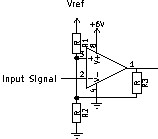I'm pretty sure I found an error in a textbook, and I would like your advice before I send it in.

It's an inverting Schmitt Trigger, built with an Op-Amp. So the Input Signal is on the Inverting Input, R3 is for hysteresis, R1/R2 Voltage Divider determines the threshold.
The textbook implies that to lower the switching threshold to ground, R1 (which goes to Vref, which is positive) should be omitted - (edit: it's not clear whether to remove R1 or bypass it, it just says to use a Resistor from Noninverting to Ground. If interpreted to remove R1, thereby making it infinite, the textbook would be OK, as pointed out by DarenW.)
However, I think R2, which goes to ground, should be omitted, because then the Noninverting Input would see ground and the Op-Amp would compare the Input Signal to Ground, and if it is higher than Ground, it would turn off (as is desired in an Inverting Schmitt Trigger.)
Am I right with my objection?
Answer
Am I right with my objection? No , and here's why.
Consider the three circuits.
(1) Without hysteresis we have a simple potential divider and a single threshold.
(2) Adding R3 to the output means that when the output is high (assume = V) then R3 is effectively in parallel with R1 (R1//R3). This gives the high threshold. When the output is low (assume = 0) then R3 is effectively in parallel with R2 (R3//R2). This gives the low threshold value.
(3) Removing (omitting) R1 still leaves us with a potential divider formed from R3 and R2. When the output is low (assume = 0) this gives us 0 x R2/(R2+R3) which is 0. The high threshold is given by V x R2/(R2+R3).
This is exactly what is implied in the book.
Omitting R2 instead of R1 would mean that the + input could never be pulled down to ground but would either be +V or V x R3/(R1+R3)
Note that the assumption is for an ideal op amp. (i.e. V out switches between rail voltages)

No comments:
Post a Comment